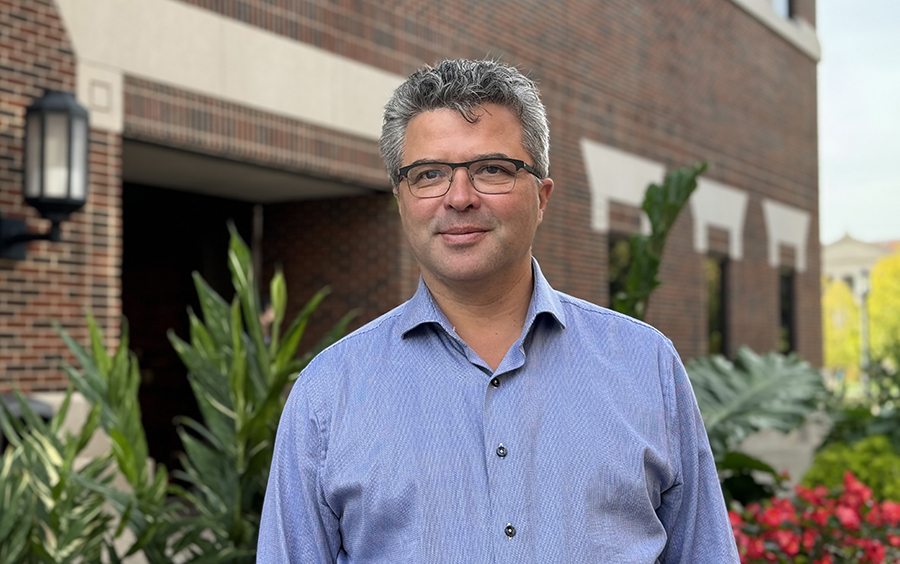Maxim Lyutikov named 2023 APS Fellow
2023-10-19

The Council of Representatives for the American Physical Society (APS) has named Dr. Maxim Lyutikov a 2023 American Physical Society Fellow. Lyutikov is a Professor of Physics and Astronomy at the Purdue University College of Science.
“I am both honored and humbled by this recognition,” says Lyutikov.
This prestigious recognition by his peers in the American Physical Society Topical Group was granted “for pioneering contributions to relativistic plasma astrophysics, greatly advancing our understanding of astrophysically important plasma processes such as relativistic magnetic reconnection and the coherent generation of radiation around compact objects.”
Lyutikov’s recognition for greatly advancing the understanding of plasma processes stems from his research work with plasma at Purdue University’s West Lafayette campus. He explains that studying plasma is of vital importance because most of the universe is plasma.
“Plasma is a state of matter where electron(s) are torn away from their nuclei, creating a soup of positively and negatively charged particles, interacting by Coulomb forces,” explains Lyuotikov. "Since Coulomb interaction has infinite range, each particle interacts with many others at the same time. This leads to complicated overall dynamics, often referred to as collective processes.”
He explains that on Earth, plasma can be studied in the laboratory, like the International Thermonuclear Experimental Reactor (ITER). Plasma on Earth is expected to serve as the ultimate energy source. Creating controlled nuclear fusion is a goal of many in this field of study. But it is more difficult to study plasmas not on Earth. Another example of plasma environment that can be studied directly is the solar wind. The solar wind is a plasma flow in near-space, about 10 Earth radii, and has velocities up to 1000 kilometers per second.
“My interests lie in astrophysical plasmas. There are two somewhat related problems of interest to me: dynamics of relativistic magnetic reconnection (a process by which magnetic energy is dissipated in plasma) and production of coherent radio emission,” says Lyutikov. “Roughly speaking, magnetic reconnection leads to acceleration of particles to relativistic velocities… highly relativistic… with velocity smaller than the speed of light by about a micro-meter per second - no typo here! These particles then produce coherent emission like having a radio in the sky.”
He goes on to explain that the biggest challenge is that there are no lab technicians who could fine-tune particles well enough that they emit coherently, in phase. Yet somehow nature finds a way to add phases correctly: both in pulsars and Fast Radio Bursts. Pulsars are rotating neutrons stars discovered more than fifty years ago and Fast Radio Bursts are mysterious millisecond-long pulses of radio emission coming halfway across the visible Universe.
“Astrophysical objects, like neutron stars and environments of black holes, offer an unusual, by laboratory and near-Earth standards, plasma regime - that of highly magnetized relativistic plasma,” he says. “Magnetic fields can reach, and exceed, quantum values of 4 times 10^13 Gauss. Even at smaller fields, in a dilute astrophysical plasma, the energy of the magnetic field can exceed the rest mass energy density of plasma. These regimes are not accessible in the lab but are common in astrophysical settings. Though many conventional plasma physics concepts can be transferred to these regimes, the differences are many, and, often, applications of well-known concepts break down in this regime.”
Lyutikov came to Purdue University in 2006 to teach and conduct research. He says he decided on Purdue because it is a highly-ranked research university in a pleasant, bucolic environment.
The APS Fellowship Program was created to recognize members who may have made advances in physics through original research and publication or made significant innovative contributions in the application of physics to science and technology. Each year, no more than one half of one percent of the Society’s membership (excluding student members) is recognized by their peers for election to the status of Fellow of the American Physical Society.
About the Department of Physics and Astronomy at Purdue University
Purdue Department of Physics and Astronomy has a rich and long history dating back to 1904. Our faculty and students are exploring nature at all length scales, from the subatomic to the macroscopic and everything in between. With an excellent and diverse community of faculty, postdocs, and students who are pushing new scientific frontiers, we offer a dynamic learning environment, an inclusive research community, and an engaging network of scholars.
Physics and Astronomy is one of the seven departments within the Purdue University College of Science. World-class research is performed in astrophysics, atomic and molecular optics, accelerator mass spectrometry, biophysics, condensed matter physics, quantum information science, particle and nuclear physics. Our state-of-the-art facilities are in the Physics Building, but our researchers also engage in interdisciplinary work at Discovery Park District at Purdue, particularly the Birck Nanotechnology Center and the Bindley Bioscience Center. We also participate in global research including at the Large Hadron Collider at CERN, many national laboratories (such as Argonne National Laboratory, Brookhaven National Laboratory, Fermilab, Oak Ridge National Laboratory, the Stanford Linear Accelerator, etc.), the James Webb Space Telescope, and several observatories around the world.
Contributors: Dr. Maxim Lyutikov, Purdue Physics and Astronomy Professor
Written by Cheryl Pierce, Communications Specialist